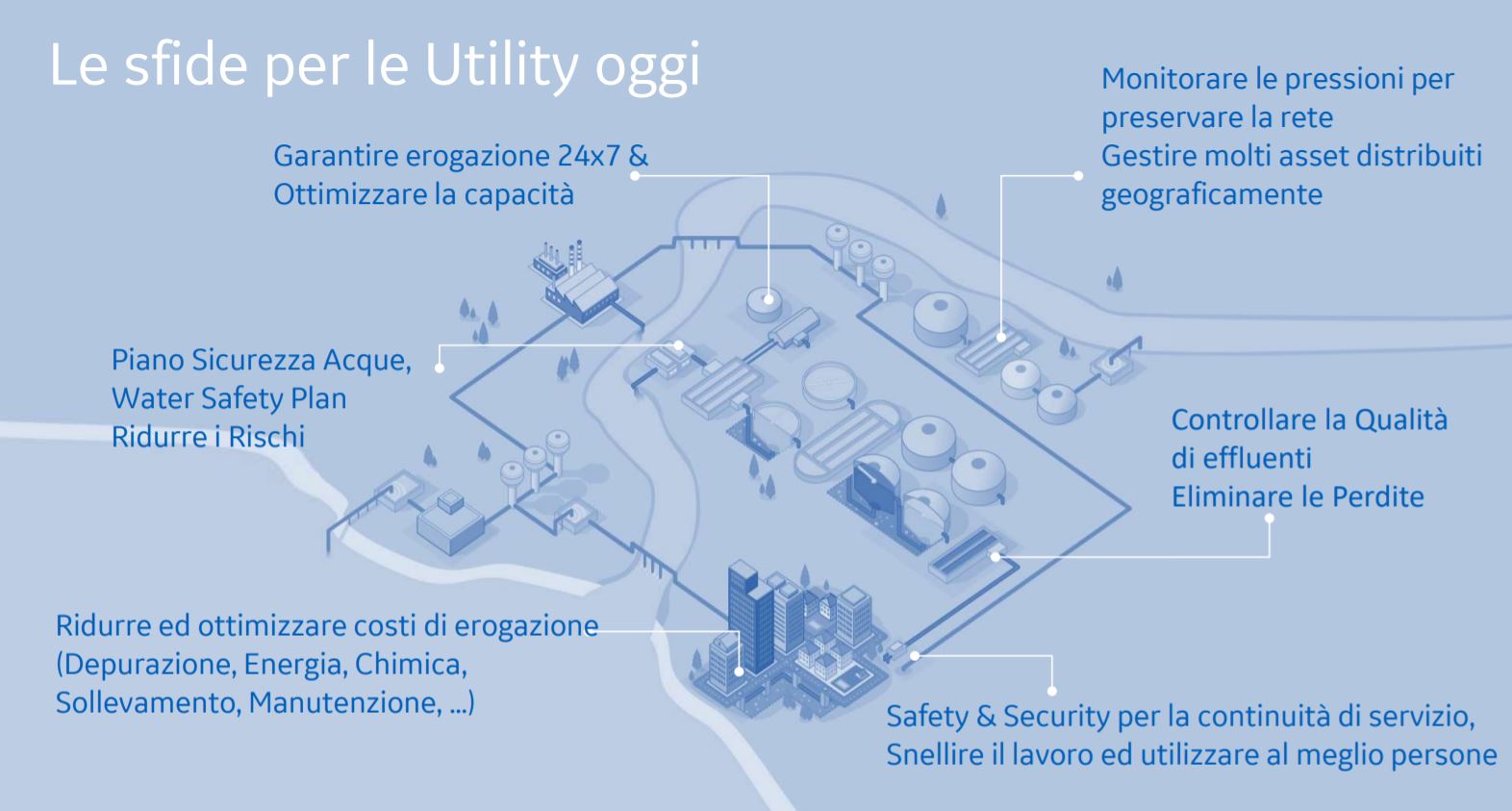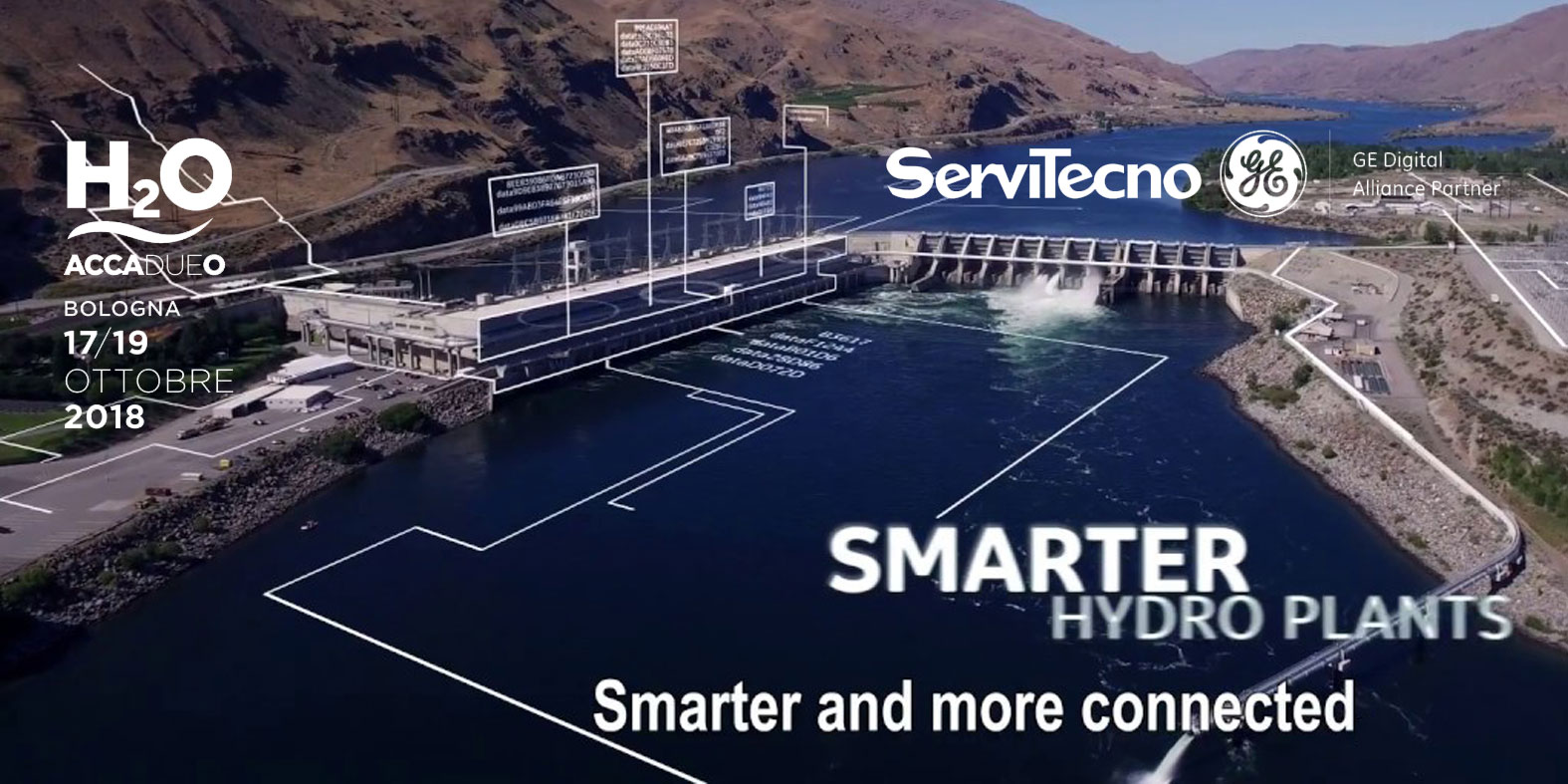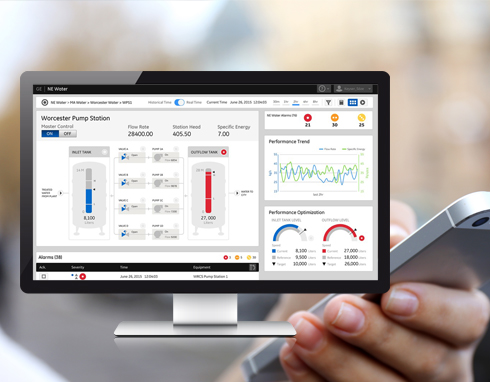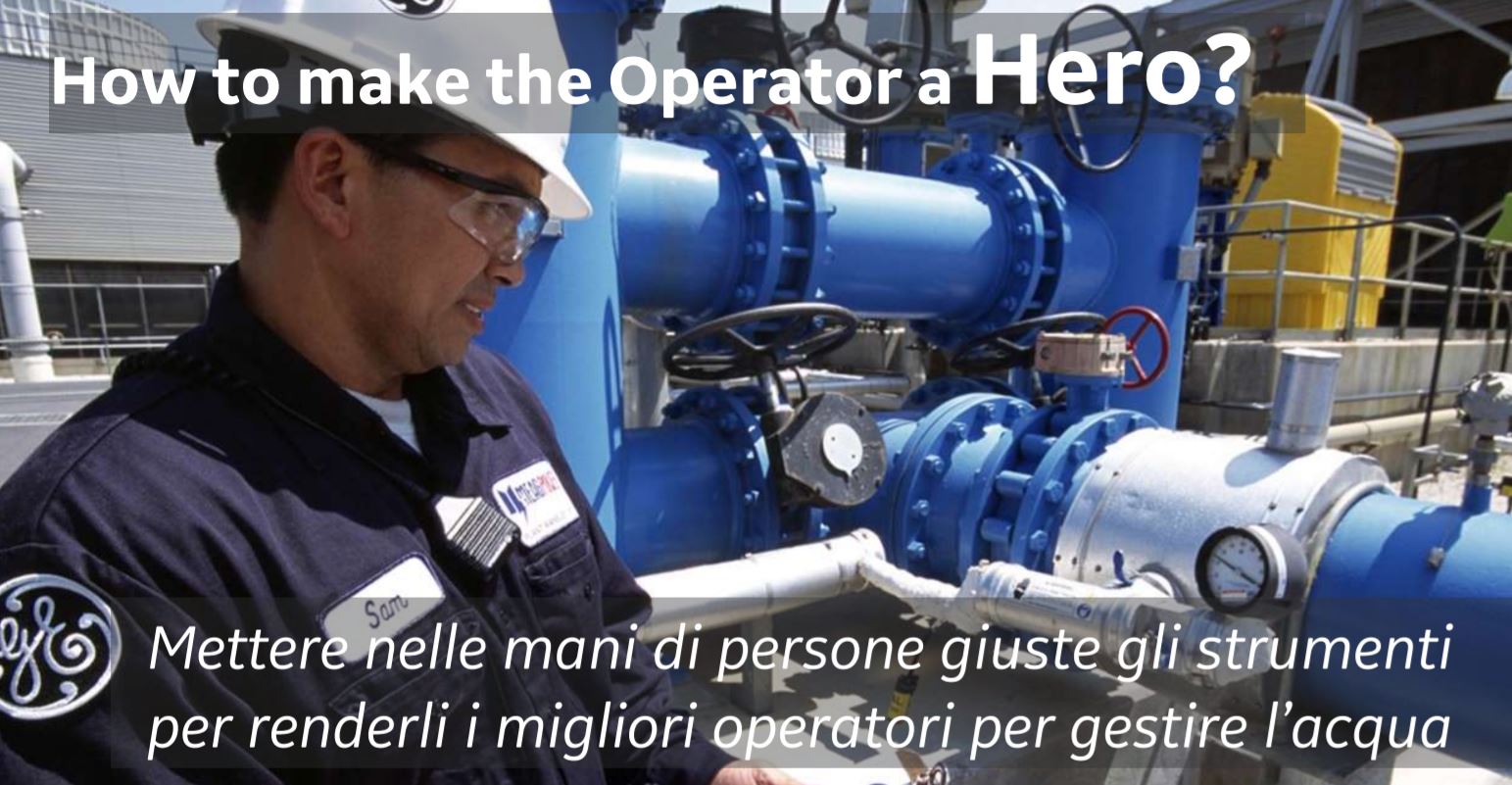YOU DIDN'T ATTEND THE CONFERENCE Acqua 4.0 (Digital Water): the evolution of remote control for the efficiency of the integrated water cycle? CLICK HERE TO SEE THE MEETING SCHEDULE: a brief report of the interventions follows.
Want to see the complete presentations? Write here
There are some issues that are currently on the table of aqueduct managers, not only in Italy and Europe, but also on a global level: Water Leakage Management, management of network pressures and cathodic protection of pipes.

These topics concern compliance with regulations that aim to improve the "product/service" offered to them by water service managers and have direct impacts on three aspects that are vital for those who run an aqueduct: Water quality, Leak checkConsumption reductionEfficiency of the facilities to ensure service continuity Verification of delivery costs.
The World Health Organization introduced the dei model over a decade ago Water Safety Plans, PSA) as the most effective means of systematically guaranteeing the safety of a drinking water system, the quality of the water supplied and the protection of the health of consumers/users/citizens.
In 2015, the Environment Directorate of the European Commission published the document "Good practices for the management of water losses”: an up-to-date technical and regulatory reference for loss management for all European managers and regulators. So here is a brief excursus of how the technology available today with sensors, control systems, remote control, monitoring of pressure points, a careful cathodic protection of pipelines in the network, correct energy management and information systems for maintenance can represent a valid complement to meet the requirements of compliance with these regulations.
PROCEEDINGS OF THE CONFERENCE
Acqua 4.0 (Digital Water): the evolution of remote control for the efficiency of the integrated water cycle

On the occasion of the event AccadueO 2018, international exhibition-conference held in Bologna every two years, ServiTecno and ATI organized an interesting and lively conference on 17 October entitled "Acqua 4.0 (Digital Water): the evolution of remote control for the efficiency of the integrated water cycle" , with the patronage of AIIC associations (Italian Association of Critical Infrastructure Experts www.infrastrutturecritiche.it ) e AIS/ISA (Italian Association of Toolmakers and in the Italian chapter of International Society Automation and Control www.aisisa.it ).
As we know, "Digitization" it is an investment driver for Industry 4.0 plans but also for Utility 4.0. In the world of aqueducts we also speak of Water4.0 (or Digital Water), to indicate how digitization can make an important contribution to the management of the integrated water cycle.
For several decades, systems have become increasingly important for the optimal management of aqueducts and wastewater.
Today, with the advent of extensive connectivity, of mobile and wearable devices, of Augmented Reality, of the Industrial Internet, of the IIoT, of BigData and of Analytics, we are witnessing an ever-increasing convergence between systems for managing plants with management, reporting and support systems decisions for who has to lead the Utilities.

In this workshop, we have seen how some methodologies, technologies and tools available today and used in the field can give appreciable results and benefits, with a positive return on investment, innovating and respecting man and the environment, reducing energy costs , helping to limit consumption and reducing losses.
User companies and technology suppliers presented practical cases and exchanged ideas, making their experiences available to the participants, which was then followed by a lively exchange of opinions. We summarize here some of the contributions by the speakers, all of high level and true experts in the sector.
After the ritual opening greetings from the organizers and sponsors, brought by Enzo M Tieghi, Chief Executive Officer of ServiTecno and shareholder of both AIIC and ISA International, the floor was given to Marco Fantozzi, one of the gurus of the water world at an Italian and international level, IWA Fellow and IWA WaterLoss Specialist Group Regional Representative for Europe and Partner at IsleUtilities.com, who as Key-note speaker opened the morning with an enlightening speech entitled "Introduction to the topic of Digital Water / Acqua4.0 for the efficient management of the integrated water cycle".
Fantozzi gave an interesting overview of the sector, speaking of challenges and opportunities in relation to the sustainability and efficiency of the water service in the international context and in Italy: in this regard, the KPI macro indicators introduced by the ARERA authority to measure the efficiency of the service are important.
Fantozzi then gave a glimpse beyond the horizon, that is what the aqueducts will look like in twenty years and therefore what opportunities do we have before us thanks to the digitization for the management of water resources and the introduction of new technologies such as Artificial Intelligence (AI) for optimal plant management.
He then took the floor Enzo M Tieghi who spoke about “Industrial Internet, IIoT, and Utility4.0” giving the vision of ServiTecno, that being GE Digital Alliance Partners, represents a vendor of technologies to make organization and operators efficient and effective. As? By means of systems remote control with efficient SCADA/HMI thanks to advanced interfaces, use of UX (User Experience), mobile devices, intelligence and techniques to filter e make data and alarms “intelligent”., providing tools to guide the operator to do the right things at the right times thanks to "advanced analytics" on Big Data, also evaluating Cloud architectures such as GE Digital's Predix for Industrial Internet and Industrial IoT.
We then saw the presentation of two very significant cases.
The first case, that of a large city in Northern Italy: Nicola Rivezzi, CIO of MMspa in Milan, brought his experience under the title "The Digitization of the Milan aqueduct network", or how Big Data can be used for the optimal management of an aqueduct.
The utility Milanese has substantial investments in progress both in the infrastructural part and in the operational tools and systems, with a digitization strategy that sees and will see the use of Big Data, AI, IoT, Cloud and an eye on Cyber security.
The convergence inevitable between IT and OT, sees the use of advanced repositories, such as GE Digital's Historian for collecting data from the field, to make them available for extraction of Analytics from Big Data, and the development of a new concept of DSS (Decision Support System) for plant operators and managers.
The second case comes from the South, from Palermo in Sicily with the title "AMAP, how to best manage an aqueduct with digitization", which was discussed by Roberto Bonomo of AMAP, a Palermo utility and Marco Parri of ATI, the remote control systems integration and development company that oversaw the implementation. In the illustration of the case they followed the history and evolution of the systems used for the management of the aqueduct systems: starting from 2000 to today, important investments have been made which have allowed AMAP to rationalise, expand and optimize the remote control system up to make it today an essential and strategic tool for the management of the network and the organization of the Integrated Water Service itself, with direct connection to other systems to extract useful information for management and to systems for rationalizing maintenance and interventions on the network.
The conference then saw the title intervention "How Telecontrol 4.0 can make the Utility and the territory evolve" edited by Antonio Allocca, CEO of ATI who introduced the theme by speaking provocatively of clearly changing scenarios that generate new opportunities: changing weather, resources and supply and consumption models; new regulations and utility aggregation; new advanced technologies.
Therefore, digitization must lead to true "digital transformation" understood as a cultural evolution that arises from the integration of technology, business and the human factor to lead to a better use of resources and the territory.
Obviously there are also risks in this journey, but these can be mitigated by having very clear objectives and tools (and a Remote control 4.0 can be one of these) and above all by relying on qualified partners to seize opportunities while preserving value and considering the data generated as corporate assets to protect.
Two international interventions with foreign speakers then followed.
The first with the title “Smart water devices: an European perspective” by Michael Ramlau Hansen of AVK Holding A/S. The Danish expert illustrated the objectives of the "2030 Sustainable Development Goals" of the United Nations, which have an impact on the world of water, in particular the "Goal6 Clear water and sanitation", and how Smart Water can be achieved with the use of Smart Devices from a Smart Water Network/Digital Water Utility perspective.
Interesting practical cases were then illustrated with the use of "intelligent products" for network management which led to consistent improvements in the KPIs through the relationship between pressure reduction and loss reduction.
A last presentation saw an interesting contribution entitled “IoT and Predictive Maintenance in Water 4.0 applications – in practice” with Polish expert Maciej Sawicki from Control System as speaker, who made an overview of several significant experiences where advanced remote control systems have led to improvements in the efficiency and yield of the aqueduct network and how distributed systems that use IoT models and architectures can be very effective in terms of predictive maintenance.
At the conclusion of the conference, the experts set up a stimulating round table with contributions and questions from the audience, where we saw how the Digital Water / Acqua4.0 theme is of absolute interest for those who have to manage the "digital transformation" of the Utility towards optimal management of the integrated water cycle, to preserve and enhance the water resource, the environment and the territory itself.

THE SERVITECNO PROPOSAL
Pressure monitoring in the network and Quality.
One of the key points in the model to be adopted to ensure homogeneity in both the quality and continuity of service delivery and reduction of consumption is the correct monitoring of the pressure points in the aqueduct distribution network through a series of sensors connected to the remote control able to bring together the information on the pressures detected in the various points of the network during the provision of the service on an ongoing basis, so as to be able to build the operating model in the different time slots of the day and in the different seasons of the year, even in consideration of any variations in the population, climatic data, trends in atmospheric precipitation and water quality parameters.
Pressure sensors, data collection and transmission Sensor modules for pressure management Inventia MT723 e MT723PT, distributed and supported by ServiTecno, they are specially designed to allow timely collection of these pressure and quality measurements, they are able to transmit the data to the remote control system (SCADA) using GSM/GPRS technology available everywhere and at low cost. Especially the modules MT723PT they are equipped with an integrated pressure sensor as well as some auxiliary I/Os for further input signals coming from other probes (pressures, levels, flow rates, temperatures, PH, conductivity meters, etc.) and any outputs (to control motors, pumps, shutters, etc.)
The module MT723PT allows a data logging, can communicate with other modules on the same GSM/GPRS network and with the remote control center with periodic direct connection and upon request via APN and SMS.
It is equipped with an integrated antenna and can be connected to an antenna with a few meters of cable for possible installation in manhole covers several meters deep, while still guaranteeing regular data transmission. The compliant module bay IP 68 and ventilation with membrane technology allow installation in "difficult" environments without external power supply and with internal batteries.
Corrosion and the importance of coating underground pipes
Metal pipes, works and structures buried or immersed in water, if not adequately protected, are by their nature subject to corrosion.
Corrosion damage causes cracks and holes that lead to leaks and burst pipes. However, the damages do not consist only in the need to repair and/or replace the corroded parts, but above all, in the damages caused indirectly, such as the suspension and quality of the delivery service, the loss of production, the decrease in the efficiency of the systems etc., without then calculating the problems that may derive from explosions, fires, floods, collapses, which may be dangerous for the safety of people and have repercussions on the surrounding environment.
Corrosion normally occurs in those points of the metal pipe where the coating is damaged or absent.
For this reason, the fundamental rule to follow, in order to minimize the risks of corrosion of a metal structure, is to ensure the integrity of the external coating: the coating must be physically and chemically resistant, and prevent or minimize the establishment of currents natural corrosion, as well as the exchange of currents, present in particularly aggressive earth laying environments.
These environments are certainly influenced by power lines and railway lines even kilometers away.
Cathodic protection: passive and active
To combat corrosion, the pipes are equipped with a protection system created through a double way: passive protection and active protection.
Passive protection, as we have already said, is the set of measures designed to insulate the pipes electrically and mechanically from the environment in which they lie in order to isolate it from any other foreign structures present.
Passive protection coatings which in any case significantly reduce corrosion phenomena are often not such as to constitute an integral protection system as they are unable to avoid the corrosion phenomena which are generated both by coating failures caused during on site of the pipes, both due to the natural degradation of the coating itself accelerated by the aggressiveness of the soil, and finally due to particular electrical conditions in the area.
We therefore intervene with active protection or cathodic protection: this type of defense has the purpose of managing the current flows present in the pipe and in the ground, so as to make the entire surface cathodic, i.e. making it more negative. The protection is complete when the potential in of the underground metal structure is in every point and in every instant equal to or lower than the electrical immunity threshold. This is obtained by placing an electric circuit between the pipes and the ground capable of investing the entire pipe with direct current, wandering in the ground and suitably dispersed so that the current itself then leaves the pipe at certain points of dispersion through one or more specially placed metal conductors.
Active cathodic protection: measurement and control to make it effective
INVENTIA, a company that designs and manufactures devices for telemetry, M2M, IIoT etc. (whose products are distributed and supported in Italy by ServiTecno), in close collaboration with the expert Cathodic Protection specialist Prof. Maciej Malicki of SPECKOR, has developed and presents the two new forms MT-652 and MT-651, specifically designed to monitor parameters and control cathodic protection installations of pipelines, tanks and other metal structures buried in land or submerged in water.
Based on many years of experience in various telemetry solutions and extensive knowledge of cathodic protection, the modules meet the needs of industry companies, municipal utilities, integrators and users of this type of installations. Both modules are packaged in a glass fiber reinforced plastic enclosure providing IP65 protection.
These modules designed for cathodic protection and with integrated telemetry functions: both the MT-652 and the MT-651 are equipped with an internal GPS receiver, which is an extremely important feature in such cases: in addition to geographic positioning, it is used for precise synchronization of the device's internal clock, on the basis of which sequential measurements are made and then marked with a timestamp.
As with all the most recent modules proposed by INVENTIA, the modules presented here are also MT-651/652 they support two SIM cards - this ensures high reliability in the implementation of the transmission of GPRS packets.
When the device is not connected to the network using the primary SIM card, it will try to switch to a backup SIM to still establish a data connection and provide business continuity with the remote Network Monitoring and Water Quality systems.
One of the key points in the model to be adopted to guarantee homogeneity both in the quality and in the continuity of service delivery lies in the monitoring of the network and therefore the adoption of a remote control system with acquisition, collection and logging of data (SCADA and Historian) for correct management of all relevant points in the aqueduct distribution network.
It is important that the remote control system is supported by one for the collection and storage of laboratory data and information that can be easily referred to the measuring points in the field.
These are features found in products like historian, in which it is possible to bring together data and information not only from sensors scattered throughout the territory, but it is also envisaged that data and information come from files generated by laboratory systems and instruments, which must refer to the various collection points and "attachments" to plant management reports.
The data on which to focus the attention of the managers of the aqueduct systems usually arrive via a series of sensors connected to the remote control capable of bringing together the information on the quality, flows and pressures detected in the various points of the network during the delivery of the service on an ongoing basis, so as to be able to build the operating model in the various time slots of the day and in the various seasons of the year, also in consideration of any variations in the population, climatic data, the trend of atmospheric precipitation and water quality parameters.
Telecontrol, SCADA, Historian and surrounding applications The solution proposed by ServiTecno is based on leading products GE Digital iFix, Historian e Historian Analysis, Besides Dream Report, Win911, IdusIS and MePISEnergy GE Digital iFix The iFix software package is probably the most widely used HMI/SCADA product in aqueduct remote control applications in Italy and internationally: it boasts thousands of installations in applications from a few dozen points monitored locally up to applications with tens/hundreds of thousands of data collected in large geographic areas.
Developed by GE Digital (industrial software division of General Electric www.ge.com/digital ) is distributed and supported in Italy by ServiTecno GE Digital Historian and Historian Analysis Historian is the powerful historicizer or data Historian that collects, archives and distributes high volumes of data, with excellent performance: it contextualizes the raw data collected and aggregates them into islands of information, allowing analyses, punctual reports and water balances.
As mentioned, Historian not only allows you to collect and historicize data that flow directly from the sensors connected to the remote control system, but it is also possible to insert data from files generated by stand-alone subsystems, laboratory instruments and systems or even entered manually.
Historian Analysis is the GE Historian Add-On that provides web technology clients, enabling analysis of Big Data, extraction of current and historical data for reports and continuous improvement of processes.
Dream Report for Water Balance
Dream Report® is the first software for industrial reporting and analysis easy to use and without programming, specifically created for control and remote control systems. It is perfectly suited for timely reporting on Water Quality and Water Balances.
Win911 Alarm Notification
WIN-911® is a real-time event and alarm notification package (also on smartphones) that works with the existing remote control system, and/or with SCADA systems (such as GEDigital iFix), with the aim of alerting the personnel in case of abnormal conditions. With WIN-911, operators can concentrate on their tasks while the computer does the monitoring.
IDUS Maintenance Information System The management of Assets, of interventions on the network and systems, of maintenance technicians and intervention teams are aspects which, if managed in a prudent and organized way, allow substantial recoveries of efficiency and savings in operating costs: IdusIS it can be installed and put into operation in a short time and has demonstrated fast returns on investment in many aqueducts.